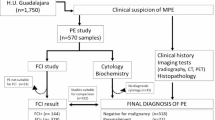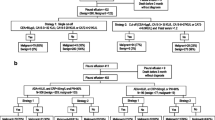Abstract
Background
Malignant pleural effusion (MPE) is a common complication caused by malignant diseases. However, subjectivity, poor sensitivity, and substantial false-negative rates of cytology assay hamper accurate MPE diagnosis. The aim of this study was to assess whether CD163+CD14+ tumor-associated macrophages (TAMs) could be used as a biomarker for enabling sensitive and specific MPE diagnosis.
Methods
Pleural effusion samples and peripheral blood samples were collected from 50 MPE patients and 50 non-malignant pleural effusion (NMPE) patients, respectively. Flow cytometry was performed to analyze cell phenotypes, and RT-qPCR was used to detect cytokine expression in these monocytes and macrophages. A blinded validation study (n = 40) was subsequently performed to confirm the significance of CD163+CD14+ TAMs in MPE diagnosis. Student’s t test, rank sum test, and receiver operating characteristic curve analysis were used for statistical analysis.
Results
Notably, CD163+CD14+ cell frequency in MPE was remarkably higher than that in NMPE (P < 0.001). In a blinded validation study, a sensitivity of 78.9 % and a specificity of 100 % were obtained with CD163+CD14+ TAMs as a MPE biomarker. In total (n = 140), by using a cutoff level of 3.65 %, CD163+CD14+ cells had a sensitivity of 81.2 % and a specificity of 100 % for MPE diagnosis. Notably, MPE diagnosis by estimating CD163+CD14+ cells in pleural effusion could be obtained one week earlier than that obtained by cytological examination.
Conclusions
CD163+CD14+ macrophages could be potentially used as an immune diagnostic marker for MPE and has better assay sensitivity than that of cytological analysis.





Similar content being viewed by others
Change history
04 August 2021
A Correction to this paper has been published: https://doi.org/10.1007/s00262-021-03023-1
Abbreviations
- AUC:
-
Area under curve
- CI:
-
Confidence interval
- FACS:
-
Fluorescence-activating cell sorter
- MACS:
-
Magnetic cell sorting
- MDSC:
-
Myeloid-derived suppressor cells
- MPE:
-
Malignant pleural effusion
- NMPE:
-
Non-malignant pleural effusion
- NS:
-
Normal saline
- RCC:
-
Renal cell carcinoma
- ROC:
-
Receiver operating characteristic curve
- SPSS:
-
Statistical program for social sciences
- TAMs:
-
Tumor-associated macrophages
References
Heffner JE, Klein JS (2008) Recent advances in the diagnosis and management of malignant pleural effusions. Mayo Clin Proc 83:235–250. doi:10.4065/83.2.235
Stathopoulos GT (2011) Translational advances in pleural malignancies. Respirology 16:53–63. doi:10.1111/j.1440-1843.2010.01890.x
Mishra EK, Davies RJ (2010) Advances in the investigation and treatment of pleural effusions. Expert Rev Respir Med 4:123–133
Morgensztern D, Waqar S, Subramanian J, Trinkaus K, Govindan R (2012) Prognostic impact of malignant pleural effusion at presentation in patients with metastatic non-small-cell lung cancer. J Thorac Oncol 7:1485–1489. doi:10.1097/JTO.0b013e318267223a
Salah S, Tanvetyanon T, Abbasi S (2012) Metastatectomy for extra-cranial extra-adrenal non-small cell lung cancer solitary metastases: systematic review and analysis of reported cases. Lung Cancer 75:9–14. doi:10.1016/j.lungcan.2011.07.014
Rakha EA, Patil S, Abdulla K, Abdulkader M, Chaudry Z, Soomro IN (2010) The sensitivity of cytologic evaluation of pleural fluid in the diagnosis of malignant mesothelioma. Diagn Cytopathol 38:874–879. doi:10.1002/dc.21303
Rodriguez-Panadero F, Romero-Romero B (2013) Current and future options for the diagnosis of malignant pleural effusion. Expert Opin Med Diagn 7:275–287. doi:10.1517/17530059.2013.786038
Basak SK, Veena MS, Oh S, Huang G, Srivatsan E, Huang M, Sharma S, Batra RK (2009) The malignant pleural effusion as a model to investigate intratumoral heterogeneity in lung cancer. PLoS ONE 4:e5884. doi:10.1371/journal.pone.0005884
Stathopoulos GT, Kalomenidis I (2012) Malignant pleural effusion: tumor-host interactions unleashed. Am J Respir Crit Care Med 186:487–492. doi:10.1164/rccm.201203-0465PP
Ruffell B, Affara NI, Coussens LM (2012) Differential macrophage programming in the tumor microenvironment. Trends Immunol 33:119–126. doi:10.1016/j.it.2011.12.001
Coffelt SB, Hughes R, Lewis CE (2009) Tumor-associated macrophages: effectors of angiogenesis and tumor progression. Biochim Biophys Acta 1796:11–18. doi:10.1016/j.bbcan.2009.02.004
Rogers TL, Holen I (2011) Tumour macrophages as potential targets of bisphosphonates. J Transl Med 9:177. doi:10.1186/1479-5876-9-177
Edin S, Wikberg ML, Dahlin AM, Rutegard J, Oberg A, Oldenborg PA, Palmqvist R (2012) The distribution of macrophages with a M1 or M2 phenotype in relation to prognosis and the molecular characteristics of colorectal cancer. PLoS ONE 7:e47045. doi:10.1371/journal.pone.0047045
Chen C, Zhu YB, Shen Y, Zhu YH, Zhang XG, Huang JA (2012) Increase of circulating B7-H4-expressing CD68+ macrophage correlated with clinical stage of lung carcinomas. J Immunother 35:354–358. doi:10.1097/CJI.0b013e31824212c4
Komohara Y, Niino D, Saito Y, Ohnishi K, Horlad H, Ohshima K, Takeya M (2013) Clinical significance of CD163(+) tumor-associated macrophages in patients with adult T-cell leukemia/lymphoma. Cancer Sci 104:945–951. doi:10.1111/cas.12167
Reinartz S, Schumann T, Finkernagel F, Wortmann A, Jansen JM, Meissner W, Krause M, Schworer AM, Wagner U, Muller-Brusselbach S, Muller R (2014) Mixed-polarization phenotype of ascites-associated macrophages in human ovarian carcinoma: correlation of CD163 expression, cytokine levels and early relapse. Int J Cancer 134:32–42. doi:10.1002/ijc.28335
de Vos van Steenwijk PJ, Ramwadhdoebe TH, Goedemans R, Doorduijn EM, van Ham JJ, Gorter A, van Hall T, Kuijjer ML, van Poelgeest MI, van der Burg SH, Jordanova ES (2013) Tumor-infiltrating CD14-positive myeloid cells and CD8-positive T-cells prolong survival in patients with cervical carcinoma. Int J Cancer 133:2884–2894. doi:10.1002/ijc.28309
Barros MH, Hassan R, Niedobitek G (2012) Tumor-associated macrophages in pediatric classical Hodgkin lymphoma: association with Epstein–Barr virus, lymphocyte subsets, and prognostic impact. Clin Cancer Res 18:3762–3771. doi:10.1158/1078-0432.ccr-12-0129
Obermajer N, Wong JL, Edwards RP, Chen K, Scott M, Khader S, Kolls JK, Odunsi K, Billiar TR, Kalinski P (2013) Induction and stability of human Th17 cells require endogenous NOS2 and cGMP-dependent NO signaling. J Exp Med 210:1433–1445. doi:10.1084/jem.20121277
Pass HI, Levin SM, Harbut MR, Melamed J, Chiriboga L, Donington J, Huflejt M, Carbone M, Chia D, Goodglick L, Goodman GE, Thornquist MD, Liu G, de Perrot M, Tsao MS, Goparaju C (2012) Fibulin-3 as a blood and effusion biomarker for pleural mesothelioma. N Engl J Med 367:1417–1427. doi:10.1056/NEJMoa1115050
Komohara Y, Jinushi M, Takeya M (2014) Clinical significance of macrophage heterogeneity in human malignant tumors. Cancer Sci 105:1–8. doi:10.1111/cas.12314
Shirabe K, Mano Y, Muto J, Matono R, Motomura T, Toshima T, Takeishi K, Uchiyama H, Yoshizumi T, Taketomi A, Morita M, Tsujitani S, Sakaguchi Y, Maehara Y (2012) Role of tumor-associated macrophages in the progression of hepatocellular carcinoma. Surg Today 42:1–7. doi:10.1007/s00595-011-0058-8
Pettersen JS, Fuentes-Duculan J, Suarez-Farinas M, Pierson KC, Pitts-Kiefer A, Fan L, Belkin DA, Wang CQ, Bhuvanendran S, Johnson-Huang LM, Bluth MJ, Krueger JG, Lowes MA, Carucci JA (2011) Tumor-associated macrophages in the cutaneous SCC microenvironment are heterogeneously activated. J Invest Dermatol 131:1322–1330. doi:10.103/jid.2011.9
Capece D, Fischietti M, Verzella D, Gaggiano A, Cicciarelli G, Tessitore A, Zazzeroni F, Alesse E (2013) The inflammatory microenvironment in hepatocellular carcinoma: a pivotal role for tumor-associated macrophages. Biomed Res Int 2013:187204. doi:10.1155/2013/187204
Walter RB, Bachli EB, Schaer DJ, Ruegg R, Schoedon G (2003) Expression of the hemoglobin scavenger receptor (CD163/HbSR) as immunophenotypic marker of monocytic lineage in acute myeloid leukemia. Blood 101:3755–3756. doi:10.1182/blood-2002-11-3414
Garcia C, Gardner D, Reichard KK (2008) CD163: a specific immunohistochemical marker for acute myeloid leukemia with monocytic differentiation. Appl Immunohistochem Mol Morphol 16:417–421. doi:10.1097/PAI.0b013e31815db477
Lau SK, Chu PG, Weiss LM (2004) CD163: a specific marker of macrophages in paraffin-embedded tissue samples. Am J Clin Pathol 122:794–801. doi:10.1309/qhd6-yfn8-1kqx-uuh6
Chung FT, Lee KY, Wang CW, Heh CC, Chan YF, Chen HW, Kuo CH, Feng PH, Lin TY, Wang CH, Chou CL, Chen HC, Lin SM, Kuo HP (2012) Tumor-associated macrophages correlate with response to epidermal growth factor receptor-tyrosine kinase inhibitors in advanced non-small cell lung cancer. Int J Cancer 131:E227–E235. doi:10.1002/ijc.27403
Ma J, Liu L, Che G, Yu N, Dai F, You Z (2010) The M1 form of tumor-associated macrophages in non-small cell lung cancer is positively associated with survival time. BMC Cancer 10:112. doi:10.1186/1471-2407-10-112
Behnes CL, Bremmer F, Hemmerlein B, Strauss A, Strobel P, Radzun HJ (2014) Tumor-associated macrophages are involved in tumor progression in papillary renal cell carcinoma. Virchows Arch 464:191–196. doi:10.1007/s00428-013-1523-0
Santoni M, Massari F, Amantini C, Nabissi M, Maines F, Burattini L, Berardi R, Santoni G, Montironi R, Tortora G, Cascinu S (2013) Emerging role of tumor-associated macrophages as therapeutic targets in patients with metastatic renal cell carcinoma. Cancer Immunol Immunother 62:1757–1768. doi:10.1007/s00262-013-1487-6
Helm O, Held-Feindt J, Grage-Griebenow E, Reiling N, Ungefroren H, Vogel I, Kruger U, Becker T, Ebsen M, Rocken C, Kabelitz D, Schafer H, Sebens S (2014) Tumor-associated macrophages exhibit pro- and anti-inflammatory properties by which they impact on pancreatic tumorigenesis. Int J Cancer 135:843–861. doi:10.1002/ijc.28736
Lim MH, Garrettc J, Mowlem L, Yap E (2013) Diagnosing malignant pleural effusions: how do we compare? N Z Med J 126:42–48
Gorgun D, Secik F, Midilli K, Akkaya V, Yildiz P (2013) Diagnostic and prognostic significance of survivin levels in malignant pleural effusion. Respir Med 107:1260–1265. doi:10.1016/j.rmed.2013.04.011
Neumann V, Loseke S, Nowak D, Herth FJ, Tannapfel A (2013) Malignant pleural mesothelioma: incidence, etiology, diagnosis, treatment, and occupational health. Dtsch Arztebl Int 110:319–326. doi:10.3238/arztebl.2013.0319
Rieux C, Boisdron-Celle M, Morel A, Fey L, Urban T, Hureaux J (2013) Biological diagnosis of resistance to erlotinib in a malignant pleural effusion. Rev Mal Respir 30:572–575. doi:10.1016/j.rmr.2013.02.010
Johnston WW (1985) The malignant pleural effusion. A review of cytopathologic diagnoses of 584 specimens from 472 consecutive patients. Cancer 56:905–909
Sriram KB, Relan V, Clarke BE, Duhig EE, Windsor MN, Matar KS, Naidoo R, Passmore L, McCaul E, Courtney D, Yang IA, Bowman RV, Fong KM (2012) Pleural fluid cell-free DNA integrity index to identify cytologically negative malignant pleural effusions including mesotheliomas. BMC Cancer 12:428. doi:10.1186/1471-2407-12-428
Kaczmarek M, Sikora J (2012) Macrophages in malignant pleural effusions - alternatively activated tumor associated macrophages. Contemp Oncol (Pozn) 16:279–284. doi:10.5114/wo.2012.30054
Mundt F, Heidari-Hamedani G, Nilsonne G, Metintas M, Hjerpe A, Dobra K (2014) Diagnostic and prognostic value of soluble syndecan-1 in pleural malignancies. Biomed Res Int 2014:419853. doi:10.1155/2014/419853
Xu C, Yu L, Zhan P, Zhang Y (2014) Elevated pleural effusion IL-17 is a diagnostic marker and outcome predictor in lung cancer patients. Eur J Med Res 19:23. doi:10.1186/2047-783x-19-23
Gong Y, Chen SX, Gao BA, Yao RC, Guan L (2014) Cell origins and significance of IL-17 in malignant pleural effusion. Clin Transl Oncol 16:807–813. doi:10.1007/s12094-013-1152-8
Gonda K, Shibata M, Shimura T, Abe N, Suzuki S, Yasuda M, Nakamura I, Ohtake T, Ohki S, Watanabe T, Fujimori K, Ohto H, Takenoshita S (2012) Changes in myeloid-derived suppressor cells in malignant effusions of cancer patients following cancer chemotherapy. Gan To Kagaku Ryoho 39:2088–2091
Romano A, Parrinello NL, Vetro C, Forte S, Chiarenza A, Figuera A, Motta G, Palumbo GA, Ippolito M, Consoli U, Raimondo FD (2015) Circulating myeloid-derived suppressor cells correlate with clinical outcome in Hodgkin lymphoma patients treated up-front with a risk-adapted strategy. Br J Haematol 168:689–700. doi:10.1111/bjh.13198
Hagemann T, Lawrence T, McNeish I, Charles KA, Kulbe H, Thompson RG, Robinson SC, Balkwill FR (2008) “Re-educating” tumor-associated macrophages by targeting NF-kappaB. J Exp Med 205:1261–1268. doi:10.1084/jem.20080108
Acknowledgments
This study was supported by grants from the National Natural Science Foundation of China (Grant Nos. 81171986, 81271815, 812111102), Research grant from the Ministry of Public Health (Grant No. 20110110001), the Basic and Advanced Technology Research Foundation from Science and Technology Department of Henan Province (Grant Nos. 112300410153, 122300410155), Funds for Creative Research Team of Henan Province, Creative Research Team of Higher Education of Henan Province, and the Innovation Team of The First Affiliated Hospital of Zhengzhou University.
Conflict of interest
All authors declare that they have no conflict of interest.
Author information
Authors and Affiliations
Corresponding author
Additional information
Fei Wang and Li Yang have contributed equally to this work.
Electronic supplementary material
Below is the link to the electronic supplementary material.
Rights and permissions
About this article
Cite this article
Wang, F., Yang, L., Gao, Q. et al. CD163+CD14+ macrophages, a potential immune biomarker for malignant pleural effusion. Cancer Immunol Immunother 64, 965–976 (2015). https://doi.org/10.1007/s00262-015-1701-9
Received:
Accepted:
Published:
Issue Date:
DOI: https://doi.org/10.1007/s00262-015-1701-9




